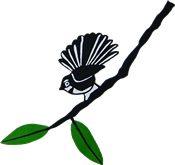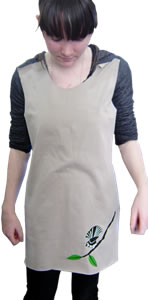Tennis dress

Meg Thompson
Wellington High School
Year 13 Fashion and Textiles Technology, whole-year project
Teacher: Kylie Merrick
Project workbook gallery
Project workbook PDF (6.4Mb)
Meg's sister, a keen tennis player, asked her to make a tennis dress to replace the shorts and
T-shirt she usually played in. Time was an important factor as the garment needed to be completed by Week 6 of term 3, ready for the tennis season. Meg discussed the requirements of a tennis outfit – that it is comfortable, easy to move in, and in a breathable fabric – and her sister's style preference, which was for a classic look that was pretty but not too elaborate.
Meg visited designer fashion stores and sportswear shops to get inspiration for her own design. She examined different features in their clothing, with an eye to what she might be able to incorporate into a tennis dress – such as the straps, ruffles, pockets, underskirts, and necklines. Meg also researched tennis sportswear and looked at the outfits worn by top international players, analysing the aesthetics and the design features that appeared to work well in practical terms.
Meg sketched a range of concept designs – outfits that would be practical for a sportsperson and look good on court – using light colours, essential for reflecting heat on a sunny day. Meg decided to design around a theme because she finds that it helps her focus and makes it easier to come up with concepts. After brainstorming some ideas she incorporated the fantail (piwakawaka), a bird her sister particularly likes and whose darting movements resemble, says Meg, the quick way a tennis player moves around the court.
After consultation with her client, Meg started to develop one of the 'fantail' dresses in beige with blue sleeves decorated with painted-fabric 'feathers'. She used cotton lycra because its stretchy quality is not only particularly suitable for a garment that needs to move with the wearer, but also means the dress could be pulled on and off over the head thus eliminating the need for zips or buttons which are potentially irritating to a player's skin.
Meg couldn't find a suitable pattern in the size she wanted so drafted her own based on her sister's T-shirt. This was an advantage, she says, as she obtained a good fit. With the Wellington weather in mind, she made the skirt section of the dress quite fitted so that it wouldn't flap up in the wind. She also drafted patterns for the other features of the dress and trialled these in knit calico. Meg consulted her client about the look and practicality of each part and asked her to test the different pocket samples to determine which was best for getting a tennis ball in and out of. Meg also trialled different ways of making the sleeve look 'feathery' and decided to make normal sleeves onto which she would sew painted feather-shaped pieces of fabric.
To avoid any last-minute construction problems, Meg also worked on the fantail motif for the dress during this stage. She showed her client some designs and, to obtain the details she preferred, merged two photos on the computer. She screen printed the final picture to check that the screen printing process worked successfully with the chosen fabric, and that the colours looked as good as she'd envisaged.
The design incorporated her sister's initials on the back of the dress and Meg also worked on this embellishment to ensure it went as planned; she trialled different machine embroidery stitches in various fonts and sizes, and made samples on the cotton-lycra knit.
During construction of the dress, Meg's sister tested it for movement to ensure it would be comfortable when she was playing tennis, and recommended the length that worked best. The only major change to the design happened when Meg started making the 'feathers', which had worked perfectly in sampling but kept curling or bunching in the cotton lycra. She would have liked to persevere and retain her original design, but practicality and function meant that she had to leave this detail and focus on plain sleeves instead.
Meg is pleased with her work and says that the dress looks professionally made and of good quality while her client, who is very happy with the outcomes, says it exceeds the specifications – and at $29 it also came well under her budget of $50.
Teacher comment
 Meg's tennis dress showed that originality and function can work together to form a very effective one-off outcome. During the process of the project, Meg was able to anticipate a wide range of problems that come about when designing and constructing active sportswear. She was able to successfully avoid problems by using good communication and frequent meetings with her client, and took on-board her expertise from past experiences. Having undertaken research that was specific and relevant, Meg had a multi-layered awareness of the issues and practicalities of tennis outfits. Her tennis dress outcome exceeded her client's expectations and could even translate from the tennis court into street wear, when worn with jeans and other casual teenage forms of clothing.
Meg's tennis dress showed that originality and function can work together to form a very effective one-off outcome. During the process of the project, Meg was able to anticipate a wide range of problems that come about when designing and constructing active sportswear. She was able to successfully avoid problems by using good communication and frequent meetings with her client, and took on-board her expertise from past experiences. Having undertaken research that was specific and relevant, Meg had a multi-layered awareness of the issues and practicalities of tennis outfits. Her tennis dress outcome exceeded her client's expectations and could even translate from the tennis court into street wear, when worn with jeans and other casual teenage forms of clothing.






